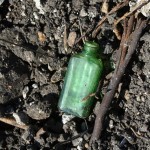
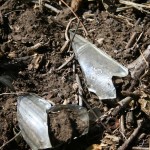
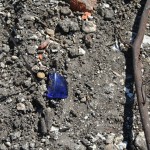
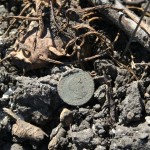
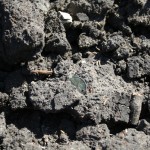

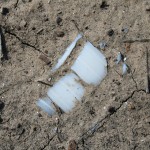
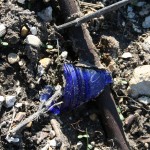
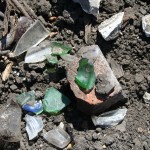
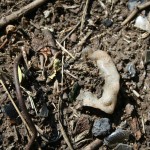
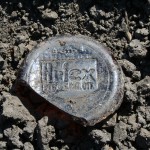
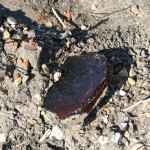
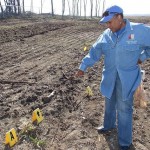
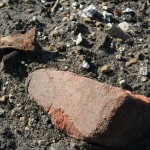
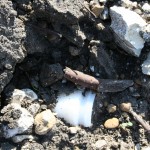
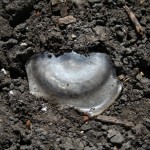
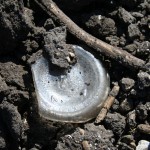

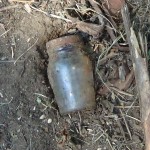


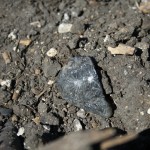
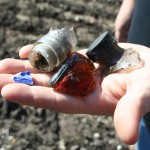 Photographs by Judy Yates EXERCPT FROM POWERPOINT PROGRAM THAT I AM AVAILABLE AS A PUBLIC SPEAKER: “Worthless Trash or Cultural Treasure: Burial Artifacts and the Symbolism in African American and Christian Cemeteries.”
Photographs by Judy Yates EXERCPT FROM POWERPOINT PROGRAM THAT I AM AVAILABLE AS A PUBLIC SPEAKER: “Worthless Trash or Cultural Treasure: Burial Artifacts and the Symbolism in African American and Christian Cemeteries.”
“Burial items placed on top of graves, especially in African American cemeteries, may look like worthless trash but almost every item may be cultural treasure with symbolism and blending of beliefs belonging to the items found on tops of the graves of the people buried there. Yes, you may find empty contemporary cans of coke or beer that may truly be trash but most of these items I will share with you are items that have been found on top of a grave or within the area of that grave. The same type of grave items may be found over and over such as coins, broken china and pottery, glassware, vases, metal pipes, bricks, marbles, toys, glasses, clocks, old glass liquor bottles, medicine bottles and jars, door locks, seashells, etc. in these little historic cemeteries.
African American cemeteries appear to have a melding of both Christian and African religions because there is one observation that the enslaved Africans brought to America believed they had been conquered by a powerful “tribe,” which was ruled by God and Jesus Christ. So the enslaved Africans accepted the new, powerful God of Christianity, mixed with the Gods and traditions that had been brought from Africa.[1]
“But most of all, the Christian description and hope of heaven was truly welcomed and a much needed escape from the earthly life of hard work as well as the horrible physical and emotional treatment of the enslaved African Americans by their new owners.”[2]
Because African American’s were unjustly enslaved, their belief was they may have been owned during life but they will not be owned in death. There was a belief that if the slave owner did not know the burial location of the slave, the enslaved African would be free to return to Africa in the Afterlife.[i]
During slavery, African American graves would usually be marked by a field stone, metal pipe, seashells, broken pottery and glassware, light bulbs, broken mirror, rosebush, shoes, coins, vases, cups, toys, iris, etc., and the location of the grave would be handed down as oral history to each generation. Also, it was a Kongo belief that anything of value to the deceased or was touched by the deceased loved one was placed on their grave. [3]
Usually, African American cemeteries were to be kept completely overgrown, especially if burials had ceased, because it was hoped that the dead will not be disturbed by the living if the graves are lost under the green vegetation.[4]
In other African American and Christian cemeteries the graves are completely scraped clean of any grass. The reason for this was because it was a sign of disrespect for livestock to urinate or defecate on a grave; prevent grass fires; prevent snakes which were the devil and the sandy soil looked like the dirt of Africa.
The following are African American and Christian beliefs that are still found in our Texas historic cemeteries. Some of these burial artifacts and their symbolism were found in the historic 1860 St. Mary Cemetery in Ellis County, Texas that has been partially destroyed:
1.The Nagwas of Ghana and in the Congo Basin of Central Africa,[5] have their graves face in an east/west direction-Christian symbolism that our loved ones were to face the rising of the sun in the east to see the second coming of Christ. A person should not sleep or be buried crossways with the world. It also symbolizes the African tradition that their loved ones will face their homeland of Africa in death. One may have been enslaved in the past, but death meant going home and was a great celebration.[6] (The graves in the St Mary Cemetery are placed in an east/west direction).
In African American/ Christian cemeteries if one committed murder or, unfortunately, suicide, they were buried in a north/south position so not to be able to see the second coming of Christ.[7] The north-south axis was considered an evil axis in West Africa. (At this time, no graves in the St. Mary Cemetery were found to be in a north/south direction.)[8]
- The early burials were never in neat rows as in white cemeteries. As long as their grave was with family, “the graves were placed here and yonder.” [9]
- The cemetery was usually placed near water in African American cemeteries because it was believed that their spirits of those buried would return to their beloved homeland of Africa by using nearby water as their method of travel into the afterlife. There is a Gullah saying that explains how the sea that brought the Africans to this world would also take the people back to Africa in the afterlife.[10](St Mary’s Cemetery was located next to a creek but the creek was filled in by the new land owner in 2013.)
The West African Bakongo belief was to place items on the graves that would be connected to water such as cups, glasses, vases and seashells.[11] (At the St. Mary Cemetery pieces of cups, glasses, bowls and vases were found in thousands of broken pieces because of being plowed over and over by the land owner employees. No seashells were found at this time.)
It was believed that the sea shell encompasses the soul’s immortal presence. The scallop shell symbolizes a journey, as well as representing the sea that brought the Africans to America and would take them back to Africa in the afterlife.[12]
The conch shell represented the sign of rebirth as well as symbolized the female and male reproduction organs. The thicker shell is male the thin shell is female.[13]
The most popular shell used has been the oyster shell bleached white and placed in rows on top of graves. Because a shell may contain a pearl, it can also symbolize good luck and prosperity. [14]
Seashells were used as decoration as well as providing a practical purpose by covering the graves with solid rows of shells which kept the grass from growing on the graves.[15] The Yoruba used seashells as grave decoration.[16] (In Sunnyvale, Texas, we have a couple of graves that are entirely covered with oyster shells in cement in Anglo cemeteries. Since the days of slavery, African Americans took care of the Anglo cemeteries and their African burial traditions were blended with the Christian beliefs which are still used in African American and Christian cemeteries to this day.)
- The African belief of being buried in a family plot with family to prevent their loved one from wandering forever here on earth looking for their family.[17](Throughout the St. Mary Cemetery families are buried together.)
- Light bulbs or oil lamps found on top of graves symbolize lighting their loved ones way to heaven [18] (Broken light bulbs were littered in the plowed up west end of the St Mary Cemetery. The archaeologist also found a piece of an antique blue light bulb that still had the filament attached to it in the plowed, oldest part of the St. Mary Cemetery.)
- In West and Central Africa, mostly a Kongo tradition, the last plates and glassware that the deceased used were broken over the grave because of the belief that this would break the chain of no more deaths in the family.[19]( In the St. Mary Cemetery pieces of broken Blue Willow china, salt pottery, press glass glassware were found not only in the new road built by the land owner but also in the west side plowed field that once was the oldest part of the St. Mary Cemetery. The graves were never moved from under the new road, new fence and plowed and corn planted west end of the St. Mary Cemetery. Two archaeologists found 14 anomalies (possible graves) that were possibly located under the new road, new fence and plowed field. Broken china and glassware can still be seen in the fenced in area of the St. Mary Cemetery that also has tombstones marking the graves.[20]
- Kongo belief medicine bottles that the loved one used before death were placed on the graves upside down because of the belief that the medicine would absorb into the ground and cure their loved one in the afterlife. [21]Also, it was believed that the inverted bottles outlining the grave shape created the “luumbu” or protective enclosure for the buried loved one. (At St. Mary’s Cemeterey, pre 1970’s glass Vick’s Vapor rub jars to old medicine bottles such as 1906 Milk of Magnesia bottles as well as multiple antique colored medicine bottles were found in the dirt of the Creek Land and Cattle Company plowed field of the oldest west side of the cemetery . )
- Metal pipes were used as burial markers. Kongo belief was if the metal pipe was left open at one end, the soul could pass between the world of the living and the dead. But if the pipe was closed, the soul would have to remain in the grave.[22] (Metal pipes marking graves were found in the St. Mary Cemetery as well as the plowed oldest west part of the cemetery).
- Iris was used because usually the graves were mounded up with dirt to allow the grave to settle and the Iris kept the dirt in place. The greenery of the Iris symbolized the reeds where Moses was found.[23] And the blooms of the Iris symbolized resurrection. (Iris marking graves was found in the St. Mary Cemetery as well as in the plowed area of the west side of the cemetery).
- Evergreens such as cedar and oak trees were planted which represented immortality because they remained green year round. This is also a Kongo-Angola belief that if a tree is planted on top of a grave that the loved ones spirit will live on in the tree.[24](Trees and green shrubs were in the St Mary cemetery on the west side and were bulldozed by the land owner employees.)
- Mirrors found on top of graves are called a ghost mirror which symbolized keeping the living as well as the dead safe. If an evil spirit looked into the mirror, it would be so repelled, it would leave the cemetery and never return to do harm to the living or dead.[25](At this time, no mirrors were found, but may be in plowed west side of St. Mary Cemetery).
- In African American cemeteries, it was almost compulsive that families would stay together in death by being buried in the same family plot so their spirit will not wander the cemetery looking for their family.[26] The Ashanti people of Ghana have segregated clan cemeteries called Samanpow which means “thicket of ghosts.” The family cemeteries would be enclosed by pole or stick fences.[27] (Rod Iron fencing as well as concrete kerbing was found in St. Mary Cemetery. On the west side of the St. Mary Cemetery that was plowed and corn planted, family members shared that brick kerbing was around family graves. Pieces of brick were found among the plowed field of the St. Mary Cemetery).

I love your website! This lesson plan is perfect for one of the lessons I’ve planned for my B2 level class.
http://kernic.evenweb.com/ http://kernic.evenweb.com/
I am thrilled you loved my website! I will be posting different types of cultural cemeteries in the future as well as their symbolism. If there is anything you would like to see on my web site just let me know. Thank you again, Dr.Graveyard